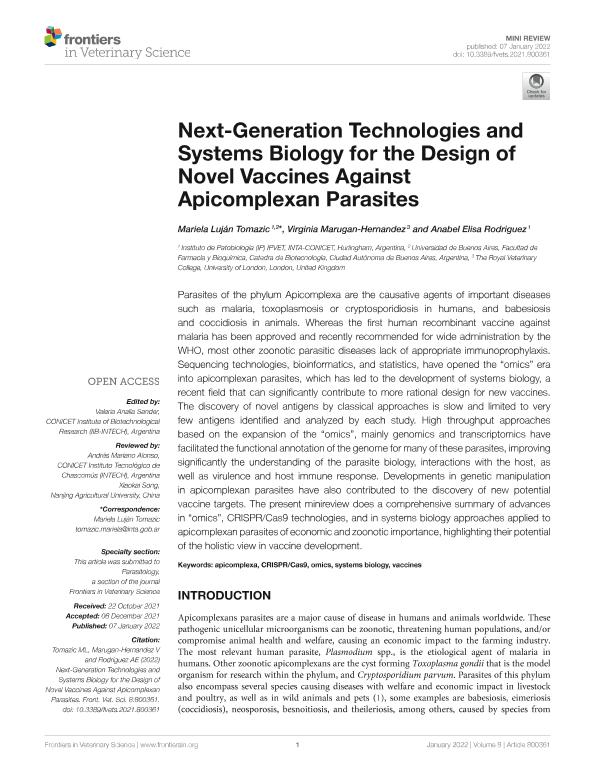Mostrar el registro sencillo del ítem
dc.contributor.author
Tomazic, Mariela Luján

dc.contributor.author
Marugan Hernández, Virginia
dc.contributor.author
Rodriguez, Anabel Elisa

dc.date.available
2023-09-28T18:08:10Z
dc.date.issued
2022-01
dc.identifier.citation
Tomazic, Mariela Luján; Marugan Hernández, Virginia; Rodriguez, Anabel Elisa; Next-Generation Technologies and Systems Biology for the Design of Novel Vaccines Against Apicomplexan Parasites; Frontiers Media; Frontiers in Veterinary Science; 8; 1-2022; 1-8
dc.identifier.uri
http://hdl.handle.net/11336/213486
dc.description.abstract
Parasites of the phylum Apicomplexa are the causative agents of important diseases such as malaria, toxoplasmosis or cryptosporidiosis in humans, and babesiosis and coccidiosis in animals. Whereas the first human recombinant vaccine against malaria has been approved and recently recommended for wide administration by the WHO, most other zoonotic parasitic diseases lack of appropriate immunoprophylaxis. Sequencing technologies, bioinformatics, and statistics, have opened the “omics” era into apicomplexan parasites, which has led to the development of systems biology, a recent field that can significantly contribute to more rational design for new vaccines. The discovery of novel antigens by classical approaches is slow and limited to very few antigens identified and analyzed by each study. High throughput approaches based on the expansion of the “omics”, mainly genomics and transcriptomics have facilitated the functional annotation of the genome for many of these parasites, improving significantly the understanding of the parasite biology, interactions with the host, as well as virulence and host immune response. Developments in genetic manipulation in apicomplexan parasites have also contributed to the discovery of new potential vaccine targets. The present minireview does a comprehensive summary of advances in “omics”, CRISPR/Cas9 technologies, and in systems biology approaches applied to apicomplexan parasites of economic and zoonotic importance, highlighting their potential of the holistic view in vaccine development.
dc.format
application/pdf
dc.language.iso
eng
dc.publisher
Frontiers Media

dc.rights
info:eu-repo/semantics/openAccess
dc.rights.uri
https://creativecommons.org/licenses/by/2.5/ar/
dc.subject
APICOMPLEXA
dc.subject
CRISPR/CAS9
dc.subject
OMICS
dc.subject
SYSTEMS BIOLOGY
dc.subject
VACCINES
dc.subject.classification
Otras Biotecnología Agropecuaria

dc.subject.classification
Biotecnología Agropecuaria

dc.subject.classification
CIENCIAS AGRÍCOLAS

dc.title
Next-Generation Technologies and Systems Biology for the Design of Novel Vaccines Against Apicomplexan Parasites
dc.type
info:eu-repo/semantics/article
dc.type
info:ar-repo/semantics/artículo
dc.type
info:eu-repo/semantics/publishedVersion
dc.date.updated
2023-09-05T12:58:12Z
dc.identifier.eissn
2297-1769
dc.journal.volume
8
dc.journal.pagination
1-8
dc.journal.pais
Suiza

dc.journal.ciudad
Lausana
dc.description.fil
Fil: Tomazic, Mariela Luján. Instituto Nacional de Tecnologia Agropecuaria. Centro de Investigacion En Ciencias Veterinarias y Agronomicas. Instituto de Patobiologia Veterinaria. - Consejo Nacional de Investigaciones Cientificas y Tecnicas. Oficina de Coordinacion Administrativa Pque. Centenario. Instituto de Patobiologia Veterinaria.; Argentina. Universidad de Buenos Aires. Facultad de Farmacia y Bioquímica; Argentina
dc.description.fil
Fil: Marugan Hernández, Virginia. University of London; Reino Unido
dc.description.fil
Fil: Rodriguez, Anabel Elisa. Instituto Nacional de Tecnologia Agropecuaria. Centro de Investigacion En Ciencias Veterinarias y Agronomicas. Instituto de Patobiologia Veterinaria. - Consejo Nacional de Investigaciones Cientificas y Tecnicas. Oficina de Coordinacion Administrativa Pque. Centenario. Instituto de Patobiologia Veterinaria.; Argentina
dc.journal.title
Frontiers in Veterinary Science
dc.relation.alternativeid
info:eu-repo/semantics/altIdentifier/url/https://www.frontiersin.org/articles/10.3389/fvets.2021.800361/full
dc.relation.alternativeid
info:eu-repo/semantics/altIdentifier/doi/http://dx.doi.org/10.3389/fvets.2021.800361
Archivos asociados
